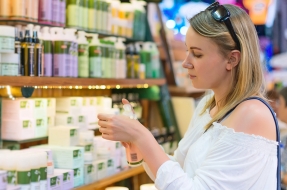How the purchase exhibitor acts as a buying decision factor?

The purchase exhibitors in the point of sale are an important piece of marketing and commercialization of some products. There can be usually found in multiple kind of stores, from specialized ones to department stores. Its purpose is to call the attention of the consumer in order to produce an impulse buying. This can be understood if we think, for example, in the cosmetics displays of the supermarket where each brand has its own stand that distinguish itself from other ones that sell the same product. Another paradigmatic case are the chewing gums exposed in the supermarket checkouts: while the buyer is waiting, he or she focus the attention on the low price and buys them even if it wasn’t planned. As we can see, it is all about a system really relevant that begins with the simple concept of the visual attraction, generated from a marketing strategy that requires a complex process of ideation and design.
Sample exhibitors
First of all, we must distinguish between the two great types of the exhibitors in the point of sale from the classification used in the blog Marketing y Comunicación sector perfumería y cosmética in its article PLV y Merchandising. On the one hand, there are the “sample exhibitors”. In this case they can be temporary, but they are mostly permanent because are the ones that can be found in perfumery and pharmacy, where it’s included a sample for the buyers. As can be seen there is less mention of impulse buying because the costumer has the option to try the product before buying it, but it is a product disposition different than the typical commercial shelves. In this case, although obviating the sample, chewing gum displays can be placed here, and of course here we can find the cosmetic displays.
Floor displays
On the other hand, there are the floor displays, mostly characterized for being temporary and because of that they demand a big brand design. In this case we find the particular product’s promotion, either because they are limited or because they correspond to concrete times of the year. It should be taken into consideration that in this kind of exhibitors is really important the display’s ubication in terms of visibility and impulsivity, as well as concept relations. For example, the batteries tend to be found in displays near electronic gadgets. So, when the costumer is buying something that needs batteries in a non-impulsive way and goes to the corridor where it can be found, he or she doesn’t need to get around to get them or they will be a reminder. Probably, he or she will think that if the batteries are placed there is because it’s better to buy them just in case. Following this topic, it’s clear that the batteries’ brand need to be involved in an attention catching design: if one thinks about the batteries that can be found in the supermarket, for sure the black and gold display of Duracell will be the one that comes to mind. So, this last point leaves no doubt about the important role that the exhibitors play in brand’s distinction and its influence in the costumers buying decision. In Marketing XXI, the chapter Merchandising y publicidad en el lugar de venta written by Rafael Muñiz claims that the percentage of planned/rational purchases is a 42% and the impulsive/irrational is 58% (inside of which a 23% are called “suggested”, and are the ones produced as a decision caused by the visualization of an attention catching product).
With all this information, and complementing it with an article written by Begoña Jordá (a teacher from UPV) called Merchandising: mejorar la presentación del producto en el lugar de venta, a conclusion based on the next statements can be reached:
The first and basic characteristic that one should take into consideration is that the exhibitors are a kind of POS advertising, so all the time we are talking about direct messages (in time and place) that the costumer receives when he or she is at the point of sale.
In the purchase exhibitors a direct advertising and promotion is carried out that support the impulse buying of the products included, creating a positive image of the product and the brand that is being bought.
It is required an important dedication in the brand’s design and must be placed in a geographically strategic way in the area where it can be found in order to catch the attention of the costumers that are on a hurry, or they are specifically going to buy a particular product. In addition, the points of sale are usually crowded and a lot of brands are competing, aspects that reinforce the importance of putting money and effort in this sense (and they will always be more economic than advertising in other media).
These exhibitors allow a much more direct personalization according to the selling product, the settlement where they can be found and the geographical disposition that they occupy inside of it.
In the temporary exhibitors case, they use to respond to specific needs of concrete campaigns: a festive season, a new product launching, an offer (2x1 discounts), to strengthen a TV ad, etc.
In the case of permanent exhibition (mostly cosmetics and pharmacy), it has to be taken into consideration that the exhibitors are distinguished by the influence capacity, and because of this they demand a constant renewal.
In any of these items becomes clear that the purchase exhibitors and the impulse buying generated are key factors in the advertising and merchandising area.



